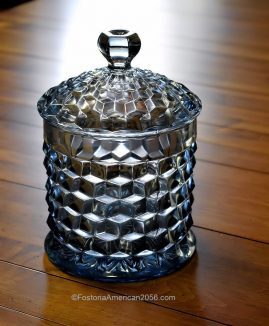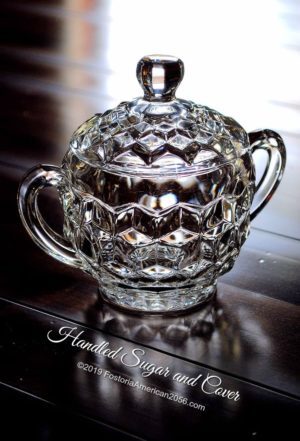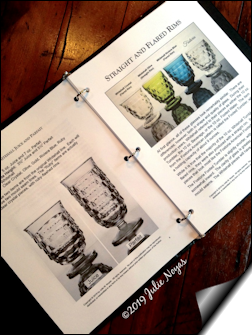by Julie Noyas | Aug 20, 2021 | Covered Containers
Item Number: 704
Approximate Size: 4¾″ H – 6½ oz.
Production Dates: 1957-1982
The Dripcut Syrup was a very popular item in the American line, and still is. Fostoria Glass made the base for the syrup; however, the top was made by the Dripcut Company of Los Angeles, California. The top dispenser is specifically designed to pour syrup quickly and as neatly as possible. With just one hand, one can release the top lever and pour syrup. The Dripcut Syrup – with its quick release lever – helps prevent a sticky mess from getting on your fingers and the table.
Other more fancy Syrups can be found in the American line; however, if you are seeking one that you can use on a more frequent basis, the Dripcut Syrup is a great choice. The name “Dripcut” was actually engraved on the slide plate mechanism on the older, original tops. If you are an avid breakfast lover that loves to serve pancakes and waffles, this beautiful Dripcut Syrup is a must-have.
The original tops were made out of metal, with a chrome plating. You can still find similar tops today and many will fit the original Fostoria glass syrup bottoms. Pay attention to the lid size and/or holding capacity noted by the manufacturer, as lids for a 6½ to 7 ounce container will usually work. Many of the newer tops are made out of plastic; however, there are some that are made out of steel, covered in a chrome finish.
As an eBay Partner, I may be compensated if you make a purchase on eBay. Here is a link to a variety of available Syrup Tops & Bases on eBay. The following link shows the available Fostoria American Dripcut Syrups on eBay.
by Julie Noyas | Aug 4, 2021 | Covered Containers
Item Number: SV-03
Approximate Size: 5¼″ H – 6 oz.
Production Dates: 1915-1923
This lovely, and very old piece, has an interesting history. To begin with, the Syrup with the Metal Handle is a pioneering piece in the American 2056 line. When it was first featured in the 1915 catalog supplement, it was described as the following: “Syrup N. P. Screw Top”. The “N. P.” refers to the item as being nickel-plated. While the handle was not mentioned, the illustration in the catalog featured a fancy metal handle. Two different handles have been seen with this piece, and the featured photo in this post shows the more plain handle.
The official name for this piece is somewhat confusing, as it appears that Fostoria Glass listed it in their catalog as being a Syrup. However, in a separate price list for the same year, they listed it as a Molasses Can with a Metal Handle. The confusion is that there already was a bigger Molasses Can pictured in the catalog, right next to the Syrup. A few years later it appears that Fostoria Glass noted this discrepancy, and thereafter it was listed in the price lists as a “Syrup”. It remained so until it was no longer produced.
As an eBay Partner, I may be compensated if you make a purchase on eBay. The following link shows available Syrups on eBay.
by Julie Noyas | Jul 22, 2021 | Covered Containers
Item Number: SV-04
Approximate Size: 5¼″ H (Syrup & Cover) – 8 oz.
Production Dates: 1938-1944
The Syrup & Cover was introduced in 1938, towards the end of the art-deco period. At the very same time, other companies offered similar designed syrup servers. The 3-piece syrup combo, which included a 6″ Syrup Plate, did not have a long life. The set was produced for only six years.
The Syrup, Cover & Plate is a beautiful combination! Please be sure to read the post on the Syrup Plate, as these are often misidentified. They were made from the mould of the 6″ Bread and Butter Plate; therefore, they look remarkably similar. The main difference between the two pieces is that the Syrup Plate will “usually” have taller side edges and a slightly deeper indentation in the center of the plate (to accommodate the Syrup).
The catalog data states that the Syrup is about 3¾″ high; however, that measurement is only accurate when measuring the Syrup without the Cover. Since the Syrup & Cover was never sold without the top, the measurement I have stated above (5¼″) is referencing the height of the Syrup with the Cover on. The holding capacity of 10 ounces was also inaccurate in the catalog data. A more accurate holding capacity would be approximately 8 ounces, which I have disclosed above.
As an eBay Partner, I may be compensated if you make a purchase on eBay. The following link shows available Syrup Servers on eBay.
by Julie Noyas | Jul 8, 2021 | Covered Containers
Item Number: SV-01
Approximate Size: 5¼” H – 6½ oz.
Production Dates: 1939-1943
This particular syrup server is different from the others in the American line, mainly because it has a Bakelite handle. The Sani-Cut Server was offered for just a few years. The country was at war when this item was discontinued. It is highly probable that this was a contributing factor for the short life of the Sani-Cut Server, especially since Bakelite products were used for wartime equipment during World War II.
The Fostoria catalogs only showed one shape for the handle of the Sani-Cut Server. It is the softly-rounded shape that is shown in the photo above. While the catalog did not specify the color of the handle, it is unofficially referred to as “Butterscotch”. One can find replacement tops for the Sani-Cut Server that display different colors and shapes of the handle; however, the original version from Fostoria Glass will have the smooth, rounded handle.
As an eBay Partner, I may be compensated if you make a purchase on eBay. The following link shows available Syrup Servers on eBay.
by Julie Noyas | Oct 7, 2020 | Covered Containers
Item Number: 362
Height: 8⅞″
Production Dates: 1915-1970 (under different names)
When this piece of glass was first introduced into the American 2056 line, it was called the Cracker Jar & Cover. Later in years, circa 1933, it was reintroduced as the Pretzel Jar & Cover. It remained so until 1944, when this item was discontinued. It would reappear later, around 1957, as a Cookie Jar & Cover.
These pieces can vary by about ¼” in height, and most of the time that can be attributed to the size of the clear band of glass seen at the top of the jar. The jar opening has a diameter of approximately 5¾”, with a smooth (non-serrated) rim. In years past, the bottom jar piece was sold to other companies that fitted them with wooden tops and other accessories to be sold as cigar and Tobacco Humidors.
 After the mid-to-late 1980’s, the mould for this piece was in the hands of different glass companies – Dalzell Viking Glass, etc. Since the Fostoria Glass factory had already closed down, Dalzell Viking was contracted to produce a variety of American pieces from original FA moulds. The Cookie Jar & Cover was one such piece. Dalzell produced it in a Blue Gray color (seen here) and a Cranberry Mist color. A couple of other colors were made by the L.E. Smith Glass Co.
After the mid-to-late 1980’s, the mould for this piece was in the hands of different glass companies – Dalzell Viking Glass, etc. Since the Fostoria Glass factory had already closed down, Dalzell Viking was contracted to produce a variety of American pieces from original FA moulds. The Cookie Jar & Cover was one such piece. Dalzell produced it in a Blue Gray color (seen here) and a Cranberry Mist color. A couple of other colors were made by the L.E. Smith Glass Co.
As an eBay Partner, I may be compensated if you make a purchase on eBay. The following link shows available Cookie Jars on eBay.
by Julie Noyas | Jan 3, 2019 | Covered Containers, Cream & Sugars
Item Number: 673
Approximate Size: 5¼″ H
Production Dates: 1924-1982
 The Handled Sugar and Cover is the only sugar server in the American pattern that was both handled and covered. It was introduced into the 2056 line in the mid-1920’s and remained a popular item for many years. The Handled Sugar and Cover is larger than the Tea and Individual Sugars, making it the perfect sugar dish for serving a large gathering.
The Handled Sugar and Cover is the only sugar server in the American pattern that was both handled and covered. It was introduced into the 2056 line in the mid-1920’s and remained a popular item for many years. The Handled Sugar and Cover is larger than the Tea and Individual Sugars, making it the perfect sugar dish for serving a large gathering.
While this particular item was not sold in an official set, Fostoria Glass did produce a great companion piece in the Cream. These two items, when paired together, make for a beautiful presentation. Due to their bigger size, they look quite appropriate sitting on a dinner or banquet table that has been set for multiple guests.
Contrary to popular belief, the Handled Sugar was also available without a Cover! The Handled Sugar, without a lid, is about 3¼” tall. They were cataloged as separate items, and one could purchase either the covered version – or just the sugar bowl (without a lid). The covered version is item #673; the uncovered version is item #674.
The Handled Sugar and Cover is about 5¼″ tall. The sugar bowl has a smooth top rim, void of any serrated edges. This is an item that disproves the age-old myth that we so often hear, “All Fostoria American pieces have three seam lines.” The Handled Sugar and Cover has a total of four mould seam lines – both in the sugar bowl itself, and also in the Cover.
As an eBay Partner, I may be compensated if you make a purchase on eBay. The following link shows available Handled Sugars on eBay.

 After the mid-to-late 1980’s, the mould for this piece was in the hands of different glass companies – Dalzell Viking Glass, etc. Since the Fostoria Glass factory had already closed down, Dalzell Viking was contracted to produce a variety of American pieces from original FA moulds. The Cookie Jar & Cover was one such piece. Dalzell produced it in a Blue Gray color (seen here) and a Cranberry Mist color. A couple of other colors were made by the L.E. Smith Glass Co.
After the mid-to-late 1980’s, the mould for this piece was in the hands of different glass companies – Dalzell Viking Glass, etc. Since the Fostoria Glass factory had already closed down, Dalzell Viking was contracted to produce a variety of American pieces from original FA moulds. The Cookie Jar & Cover was one such piece. Dalzell produced it in a Blue Gray color (seen here) and a Cranberry Mist color. A couple of other colors were made by the L.E. Smith Glass Co. The Handled Sugar and Cover is the only sugar server in the American pattern that was both handled and covered. It was introduced into the 2056 line in the mid-1920’s and remained a popular item for many years. The Handled Sugar and Cover is larger than the Tea and Individual Sugars, making it the perfect sugar dish for serving a large gathering.
The Handled Sugar and Cover is the only sugar server in the American pattern that was both handled and covered. It was introduced into the 2056 line in the mid-1920’s and remained a popular item for many years. The Handled Sugar and Cover is larger than the Tea and Individual Sugars, making it the perfect sugar dish for serving a large gathering.